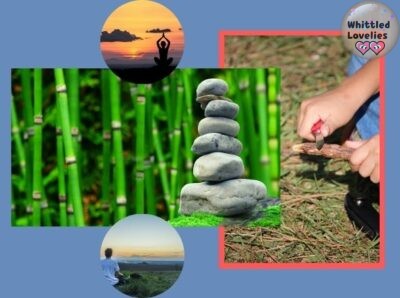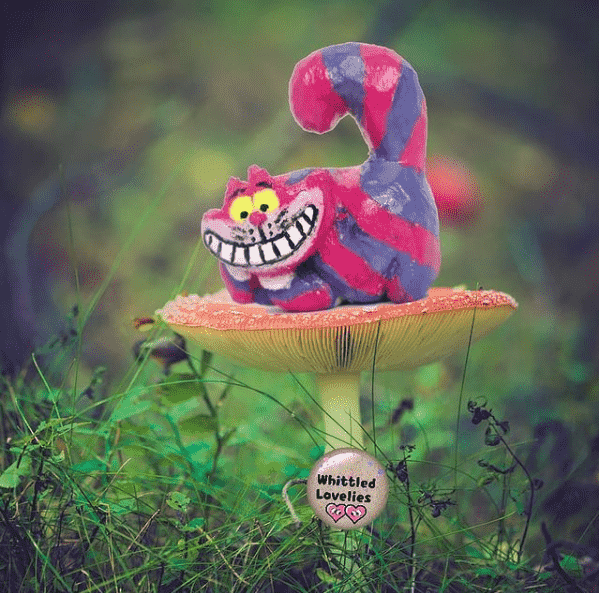
Mindfulness: how to achieve it by whittling
I have often combined the words meditation and zen in my articles when talking about whittling. When I approached the world of whittling I obviously had no awareness, but somehow it found me.
As LoeffelSuse described perfectly and unfiltered in her article, when you find an activity that really engages your mind and spirit, you forget about everything, especially your problems. But perhaps many of you are not familiar with this word: Mindfulness and the philosophy behind it, so let’s take a little step back.
What mindfulness is
“Mindfulness is the practice of purposely bringing one’s attention in the present moment without judgment, a skill one develops through meditation or other training. Mindfulness derives from sati, a significant element of Buddhist traditions, and based on Zen, Vipassanā, and Tibetan meditation techniques. Though definitions and techniques of mindfulness are wide-ranging, Buddhist traditions explain what constitutes mindfulness such as how past, present and future moments arise and cease as momentary sense impressions and mental phenomena.”
From Wikipedia, the free encyclopedia
Of course, being able to talk about Zen, mindfulness, meditation, even Buddhism in a whittling blog may seem extreme. But you have no idea how closely related it is, and in this article I will try to prove it to you.
Let’s say that, usually, when people approach this kind of practice, there are different motivations, but basically there is a great desire to change aspects of oneself and one’s life that are perceived as cumbersome, wrong or even harmful.
Most commonly one approaches these oriental practices through the practice of yoga and meditation, which are often very much linked. But if we go back to the real starting point, whittling may not be yoga, but it sure is meditation! Not convinced? Let’s see…
Do you want to bring some happiness into your life? Learn the basics of mindfulness and start carving wood!
“Meditation is a practice where an individual uses a technique – such as mindfulness, or focusing the mind on a particular object, thought, or activity – to train attention and awareness, and achieve a mentally clear and emotionally calm and stable state.”
From Wikipedia, the free encyclopedia
You may have the idea that meditation is a practice that has to be done sitting in a not-so-comfortable position, perhaps in the dark, with your eyes closed, or after yoga practice, or that you have to do who knows what other weirdness. But this is not the case, these are just some of the possible methods.
When you approach the idea of a project what do you do? You concentrate on one thought, you see the project in your mind, you see it realised and you think about how to get to your end result. And that is meditation! You have stopped the inner chattering of your mind for a moment, totally absorbed in one thought.
When we start carving, what happens? We follow an instinct, you find yourself plunging a knife into the wood, letting go, not thinking about anything anymore and just enjoying the moment in the present. A blade slides and produces a lot of wood flakes. In your hands something that before had a shape, suddenly this shape changes, sometimes even the colour changes and even if you are surprised by it, you are the one who gave life to this change. And that is mindfulness!
The mere fact of finding yourself concentrating, taking care not to ruin the piece with risky gestures or simply being careful not to injure yourself is a clear example of the here and now, the only really existing and important moment in our lives.
Consciousness
When you realise these things you are a bit shocked, or at least that was my first reaction. People often think that it takes a lot of practice and effort to be happy, when in fact it is much simpler. All it takes is a single moment to open this gap, and once you understand the mechanism, all that remains is to try to expand this moment to infinity.
Of course it’s not easy to see your life from the outside, just as it’s not easy to realise how much we need a change when we’re so caught up in the daily grind of life: commitments, worries, and all the damn things we can’t say no to. But more or less everyone is looking for an escape valve and as I am showing you this particular mindfulness attitude helps you to keep your mental balance healthy.
Without even realising it we are faced with the knowledge that what I am telling you is true. Think back to Susanne’s article I quoted at the beginning: she says “carving spoons saved my life“, Cousin Jack Carves in his interview tells us from his experiences that the troubled children he tutored were engaged in constructive activities such as woodcarving.
And that’s not all! Carving increases one’s self-confidence, mastery, amazement to the point of calming the mind, quoting Home Wood Spirit’s interview: “carving is a fun and creative hobby that gives us hours of time well spent“, for ourselves and for those who can benefit from our art.
The experience of mindfulness
I could tell you that by watching every carver, how he works, how he approaches projects, you can understand a lot about the person behind the knife. That is why it is difficult to tell a beginner how to organise the start of a project. What we see in the tutorials is just how the professional approaches ‘the problem’. There are certainly technicalities that need to be learned in order to have a solid foundation, but then each person works out their own theory on how to proceed. That is the real moment when you have to let go and follow your instincts, even if they are wrong.
You can carve without calculating the surface of the wood, without drawing, without making or having a clay model of the subject. Try at least once to let yourself go without thinking about the result, and maybe you will find yourself in the words of Johann Wolfgang von Goethe:
“Whatever you can do, or dream of doing, begin it. Audacity has genius, power and magic in it. Begin now.”
Johann Wolfgang von Goethe
In this way you will create experience, I don’t think there is a better way to grow than through direct experience. Only by going through difficulties can we think of a solution, or discover that the solution we found was not the right one.
You have to be ready for anything, you have to put yourself on the line. Personally, I have created the most beautiful figures of which I am most proud, such as my Cheshire cat, which were created simply by using a knife on wood. The amazement that assails me every time I see this photo is the most priceless emotion and in that moment I reach that moment of pride, that moment of happiness I so desperately desire.

The mistakes
But like life, woodcarving is not always easy or always beautiful. There are times, unfortunately many, when I fall into a state of darkness. In which I am not good enough at anything. Mainly I’m not good enough at drawing, at carving, at getting a good idea. When it’s not me I blame myself, it’s the tools, they’re not good enough, they’re not sharp enough, they’re not adequate enough, they’re few and far between, I need many more but I can’t afford them….
At that moment I’m only good at one thing. Crying over myself. And let me tell you, I am a master at making excuses! Sometimes even heartfelt, unassailable, complicated and brilliantly perfect. But what I’ve realised after delving into mindfulness is that these are nothing more than one thing. Excuses.
The time I waste making excuses about my inadequacy is time I take away from my life, from my projects. It is time that I take away from that natural instinct of happiness that makes us pursue it. Excuses are of no use to anyone. Especially not to ourselves.
You are wrong, but you are all wrong. Do you think your idol on Instagram or Youtube is never wrong? That he hasn’t also encountered periods of darkness? He has done it just like you, just like me. But do you think being wrong is bad?
I honestly thought so. I find that I am almost obsessed with perfection at times, and when I am in those moments everything goes wrong and everything goes in the least perfect way possible. The pressure I put on myself in the pursuit of perfection pushes me to make mistakes. So now, I can agree that perfection does not exist. When I realise this I fall to my knees, and rather painfully so. And I start making excuses that I have not been able to achieve it.
Do you realise how damaging this is for us, our health and our art? Haven’t you ever wondered why solving one problem at a time, and mind you, only worrying about it when it actually occurs, increases satisfaction?
We have shown ourselves, by breaking down fear, that we are actually capable of anything. And that when we don’t reach our goal it is because we have taken ourselves too seriously, we have put too much pressure on ourselves. And nothing like these things can break down our desires and take us away from perfection.
So, also thanks to mindfulness, I have come to understand that perfection lies in imperfections. Handmade things are so incredibly beautiful because they are imperfect, and as such, unique, like us! The moment of darkness, the mistake are not a bad thing. Taking fear out of the equation, the mistake is the perfect moment to teach us something.
From every mistake comes a lesson. From every problem comes one, or infinite, solutions. We would never have seen it, understood it, experienced it, if it had not happened, and if we were not in the here and now.
So let’s take up the challenge, did you fail? Now it will be better! Never lose the courage. Inside each of us is magic, light, happiness. Now that I have helped myself and you to be more aware of it, I can only wish you good mindfulness and greet you with the word Namaste (I bow to the divinity within you), may happiness be with you! 🙏🏻
This is an article written by a human for humans!
All articles in the blog are written by me. No contributors, no people paid to write content for me.
Posts written by guests or friends of the blog are marked under the title with the words “guest post.” These are friendly collaborations, contributions to the carving community.
No AI (artificial intelligence) support is employed in the writing of blog articles, and all content is made with the intent to please humans, not search engines.
Do you like my content?
Maybe you can consider a donation in support of the blog!

Click on the button or on the link Ko-fi to access a secure payment method and confidently offer me coffee or whatever you want!
From time to time, in articles, you will find words underlined like this, or buttons with the symbol 🛒. These are links that help deepening, or affiliate links.
If you are interested in a product and buy it suggested by me, again at no extra cost to you, you can help me cover the costs of the blog. It would allow me to be able to give you this and much more in the future, always leaving the content totally free.
